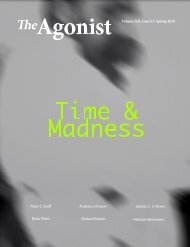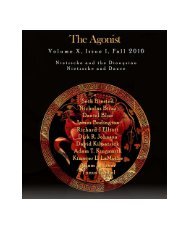Volume XI, Issue II, Spring 2018
You also want an ePaper? Increase the reach of your titles
YUMPU automatically turns print PDFs into web optimized ePapers that Google loves.
THE AGONIST<br />
conversation with his soul, which is clearly an inaudible inner dialogue or mode of<br />
external silence, and then sings his final ecstatic paeans to Life and Eternity. Thus,<br />
just as following a critique of language, The Gay Science and Beyond Good and Evil<br />
both end with songs, so too does Zarathustra, 35 therefore, there is a structural<br />
parallel to the three books.— — 36 Poems are different of course from prose,<br />
fragments, and aphorisms and are more akin to music which, unlike the former,<br />
can be given a greater multitude of interpretations — translate an aphorism and<br />
it is essentially the same from language to language, whereas Bach’s Goldberg<br />
Variations as performed by Wanda Landowska versus Glen Gould offer<br />
exceedingly unique reconfigurations that show how transformable and free from<br />
“truth” music is. In this way then, I propose that with the songs that follow the<br />
“closing melodies” or final aphorisms of those books, the sloping into the sea in<br />
proud and calm harmony, Nietzsche attempts to surpass or overcome with<br />
them the very limits of prose, which, as he proclaims, steals the color,<br />
prickliness, and fragrance of his thoughts. Since we know that poets are “liars”<br />
for Nietzsche, that is, one specific type of poet, whatever possible truths they<br />
may produce are never in danger of becoming true, but since Nietzsche is a poet<br />
of a different order, or strives to be, that is not as much of a danger for him.<br />
Poetry for him is in part a form of power. When discussing the aftermath of the<br />
death of God, Nietzsche asks, “What festivals of atonement, what sacred games<br />
shall we have to invent? Is not the greatness of this deed too great for us? Must<br />
we ourselves not become gods simply to appear worthy of it?” (GS §125) To<br />
this last daunting question, I believe there is a clue or ‘answer’—perhaps<br />
35 Taking into consideration Paul Loeb’s proposal that, although, chronologically, the<br />
fourth book follows the first three, narratively, it occurs within the third. See Paul S.<br />
Loeb, “The Conclusion of Nietzsche's Zarathustra,” International Studies in Philosophy,<br />
32/3 (2000): 137–52. Even if one is not persuaded by Loeb’s interpretation, the point<br />
of the structural parallel between GS, Z: <strong>II</strong>I, and BGE remains, and many scholars<br />
argue that Z: <strong>II</strong>I is the “real” or original finale to Z. Further, if the relationship between<br />
the three books has been recognized, since Nietzsche refers to GM as a “sonata in<br />
three movements,” it is possible that it too is somehow linked, musically, in terms of its<br />
structure, to GS, Z, and BGE. Nietzsche was intimately involved in the design of his<br />
books and informed his publisher that he wanted BGE to look exactly like GM, to<br />
resemble it so precisely that “the two books must look so much alike as to be actually<br />
confused with each other.” On this, see Schaberg (ibid.), 150.<br />
36 Although the parallel between two of the books has been observed, by Lampert in<br />
particular, if not others, what has been emphasized by him is that both Z and BGE end<br />
in songs. The much more specific and intriguing parallel noted above has not however<br />
to my knowledge been emphasized. Exploring this in detail is beyond the scope of this<br />
article.<br />
38









